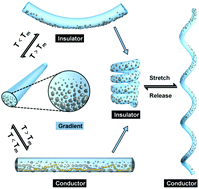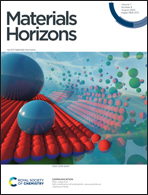Liquid metal gradient fibers with reversible thermal programmability†
Abstract
Growing interests have been received for conductive fibers due to their electrical conductivity with one-dimensional structures. Fibers with liquid metal (LM) as a conductive filler exhibit distinctive advantages, such as metallic conductivity and superior stretchability. So far, the unique characteristics of LM have not been fully used in one-dimensional materials. This work successfully created conductive fibers with an LM filler gradient dispersed in a polymer matrix. These LM fibers showed distinguished thermally programmable shapes and electrical conductivities. The fibers can be programed into straight, bent or helical shapes with controlled bending degree depending on the heat absorbed by the LM inside the fiber. Interestingly, the resistance of the LM fibers could also be tuned by the thermal energy. Upon heating, the LM fibers showed a transition from an insulator (108 Ω) to a conductor (10 Ω) with programmed conductivity along the axial direction. More importantly, both the shape programmability and conductivity transition were highly reversible by heating and cooling. The programmed helical LM fibers successfully mimicked natural plant tendrils with excellent mechanical performance and acted as smart strain-mediated conductors. The LM fibers could also be applied as flexible temperature electrical switches in high-tech devices, such as lunar rovers.



 Please wait while we load your content...
Please wait while we load your content...